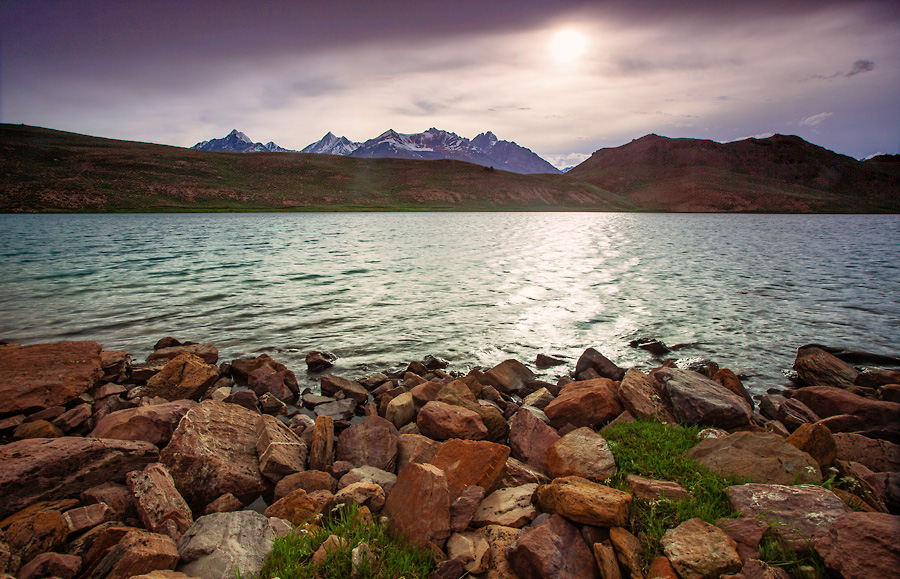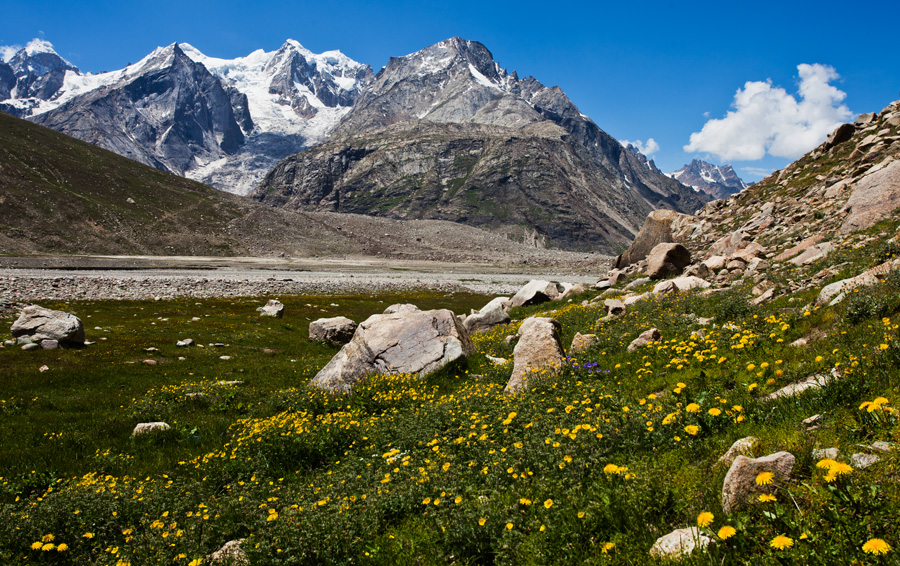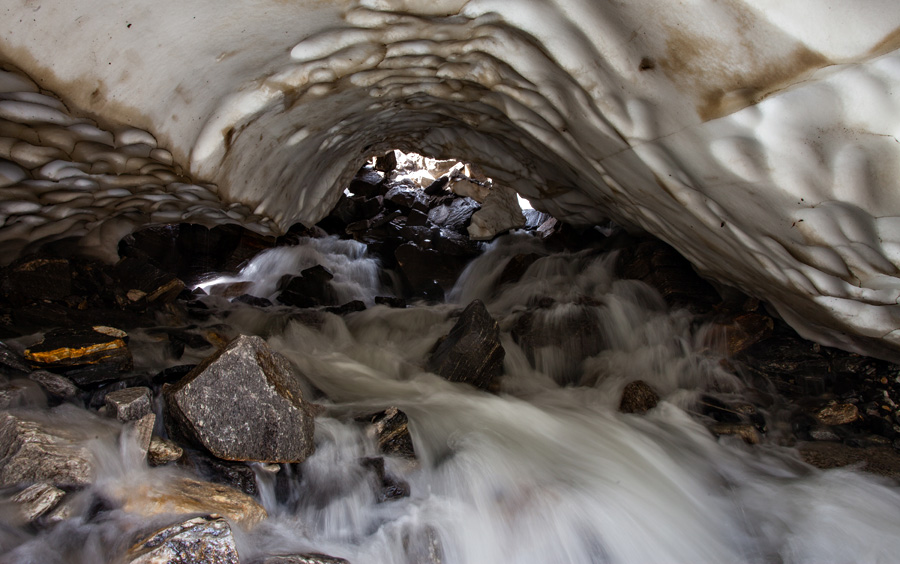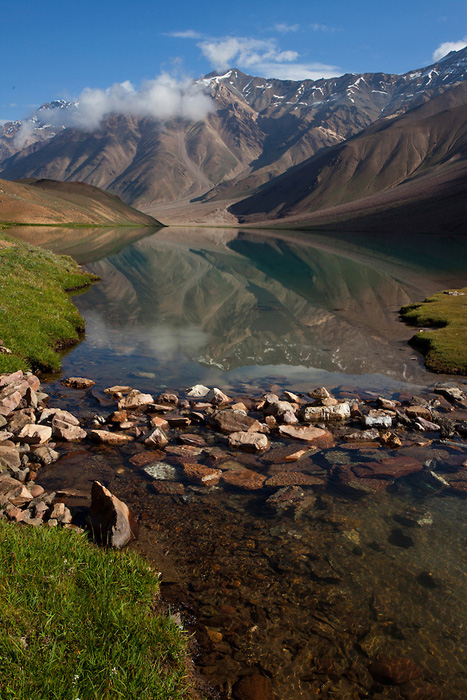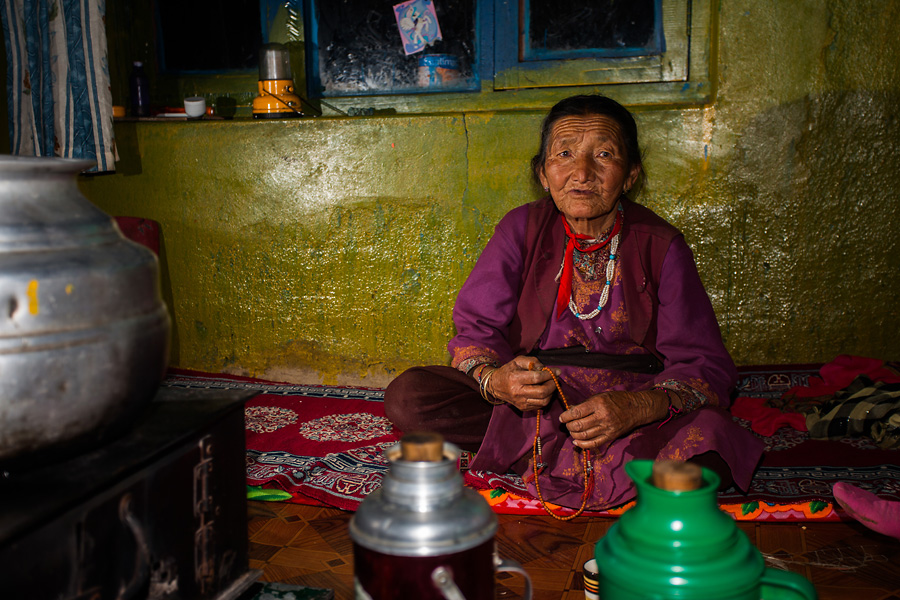Also see: Our photography tour to Lahaul & Spiti in July / August. With increased requests to join this tour, we have multiple departures options available this year to suit your calendar.
Where is the largest glacier in Himachal Pradesh located? Where do you find some of the highest permanent human settlements in India, well above 14,000 feet? Where can you find a bloom of flowers in yellow, white and purple carpeting the mountain slopes, flanked by snowy peaks on all sides every summer? Which way did people travel to the highlands of mystical Tibet when the political climate across the border permitted it? Where is the origin of abundance of waters received by the agricultural planes of Punjab?
Answers to all these questions run through one common geographical region – Lahaul & Spiti Valleys in the northern part of Himalayas. I first arrived in Lahaul & Spiti without knowing anything about the region. One fine day, I was speaking to a car driver in Manali who suggested that I should visit this region. His endorsement was convincing, and I was on my way the very next day!
I have made many such impulsive decisions to travel in a direction where the wind took me in. Looking back into my years of prolific and compulsive travels, if there is one decision that I am forever happy about, it is this visit to Lahaul & Spiti Valley almost a decade ago.
Not long after we left Manali, I was in a land that I had always presumed remote, faraway and unreachable. I had seen Himalayan snow-peaks from a distance. I had heard about valleys high and mighty located well above ten thousand feet, with mountains raising another ten thousand high. I had heard of rivers tumbling ferociously down these valleys in breakneck speed that can even move the mountains around them. All of them, I thought, were somewhere faraway, waiting as a gift reserved for a gritty explorer who bravely fought the elements. But on arriving in Lahaul, I found myself surrounded by all these things, without warning!
The valley was not just about ruggedness and might. As I observed closely in every direction, the mountains generously unfolded their beauty. The steep mountain slopes were filled with small colourful flowers that painted the world with their beauty. Sheep and horses ambled happily in the meadows chewing the tiny grass that bore these flowers. The sky remained a perfect blue all through the journey, thanks to the high mountains that blocked any attempts from the south-west monsoon to bring in any moisture into the valley. Glaciers glided slowly from the mountain-tops, letting the snow-melt to forms streams that enhanced the flow of the river. Theses streams often came down slowly and gently, often inviting us to wade through them on the road. Occasionally, I stepped out of the vehicle to feel the cold of the flowing water that lifted my spirits even when the feet went numb. Some of these streams came down from a tunnel of ice leftover from the winter’s precipitation. Being among all this, without having expected this spectacle swept me with an unbound joy.
Lahaul & Spiti tends to surprise every visitor, even those who are knowledgeable about its beauty. I have come back here five times since my first visit, each time feeling a similar excitement during every moment I spent in the valley. The first views of Chandra River meandering through the mighty valley, gaining strength with each mile, are quickly overshadowed by the muscular mountains that dominate the view. Along the way, there is a waterfall tumbling down the rocks every few minutes, some of which appear to be falling from no less than a mile high. Much of our way up the Lahaul Valley is along the flow of River Chandra, upstream.
Somewhere along its flow, the river flows next Chandratal Lake, a crescent shaped, mile-long azure water trapped between the mountains. On the opposite side of our approach to the lake is a peak that ascends in a near vertical pace. The eyes don’t perceive its altitude in the clean and crisp air here, but the crumbs of ice trapped in places indicate its loftiness. As I approach Chandratal, tiny yellow flowers in the grassland sway to the wind and welcome me into their paradise. Prayer flags flutter on the shore, indicating the holiness of the lake. The water is as blue as it can get, reflecting the clear sky without the smallest aberration. The mountains around the lake keep the wind at bay transforms the clear surface into a mirror that turns the world upside down. It’s not a place you want to leave, ever.
But one can’t stay here forever. The part of the Lahual Valley I have traversed through is completely devoid of any habitation. Chandratal is away from everywhere, about four hours drive from the nearest village and twice the distance from a town with all the creature comforts. Across a 15,000 feet pass, beyond many floral meadows and ice-covered mountains is Spiti Valley, home to a millennium old civilization. Below the pass, Losar is the first village on the road that appears eight to ten hours hours after leaving Manali. Kaza, the first town on the way is another two hours away.
Kaza is like a brief moment of return to comforts. It’s a town suffering growth pangs, as much of the region’s commerce happens here, but there is little room to expand in the narrow valley. Much higher than Kaza, at more than 14,000 feet are villages that haven’t changed considerably in a thousand years. In Langza, a small village in the mountains, houses are still built from mud. People still make a living from subsistence forming and rearing sheep. But life has improved for good in the last few decades as a road has been built connecting with Kaza, which soon followed with electricity and telephone lines. But there is no certainty of any of them functioning – roads close with a snowfall. Power and telephone connections are always unpredictable.
While the lives have changed, the attitude that Spitians have towards life hasn’t transformed with it. They are still hardworking: people don’t mind walking with their animals from morning to evening or toiling in the fields until the job is done. Or as travellers have started coming in, they now go on long treks as guides, porters, cooks or horsemen, doing everything that required physical endurance. At the same time, they have remained devout, never failing in their allegiance to the village’s Buddhist Monastery that dictates their way of life. I spent several days living in different houses in Langza, where I was cared for, fed, and assured a good time as long as I was there. The altitude was high and the rarefied air did not let me runaround with ease, although I wished to spend the time running with the kids or walking down to the fields to converse with the working villagers.
But being there was good enough. Outside my window, mountains decorated the skyline with their jagged ridges. Tallest of them was Chau Chau Kang Nilda (CCKN), higher than 6,000 meters, towering a two thousand meter above the village but standing so close that it appears just a stone’s throw away. As the night falls, CCKN glistens in the moonlight, while the stars glitter in the darkness free of light pollution.
In Spiti, there is no dearth of such pleasant experiences. I was even welcome to the valley once by an unseasonal snowfall, which, despite holding us back from journey for a while, gave us a pleasant surprise. In another occasion, we were welcomed into Langza on a festival day when villagers in traditional clothes danced in circles in the shadow of CCKN. We were often interrupted by traffic jams along the way, not a pileup of vehicles but a big herd of sheep that made the waiting a pleasure. And then there was a day when we watched the monks break into swirling dances to the gathering of a large crowd of villagers. When surprises are always waiting round the bend, you can’t not come back to Spiti year after year!
Photography Tour to Lahaul & Spiti
For five years now, we have been conducting photography tour to Lahaul & Spiti Valley in the Himalayas. Owing to our deep experiences and understanding of the region, its culture and knowledge of the photography opportunity available, the tour is getting increasingly popular and is one of our featured photography tours in our bouquet. Our strong local connections and bonding has helped keep this tour secure, reliable and well-managed despite the remoteness and ruggedness of the region. Going with our policy of keeping the groups small, we have been slowly increasing the number of departures instead of increasing the group size. Hence, this year, we have several departures available in our tour calendar. Yet, they have always been booked months in advance and the response to the tours has always been overwhelming. As some of the participants say –
“I really enjoyed being a part of it and the visit to some of the most beautiful and isolated regions in this country was truly an humbling experience. Your ability to organise such a tour and provide for such comfortable stay even in very remote areas is still mind boggling. I really enjoyed the tour and will definitely be coming back with you guys.” – Abhinav Ashok, Trichy.
“I would say the planning/organizing was top notch! The feedback sessions were wonderful for learning. It was awesome to see people’s varied perspectives on the same subject, and was awesome to see why some perspectives work and some don’t in live practical examples.” – Chandra Mulpuri, Hyderabad.
“excellent organizing and logistics… superb…” – Amit Kamat, Bangalore.
“i loved all the feedbacks and the interaction! learnt a lot about photography as well as the culture of the place.” – Sunila Rajan, Chennai.
Join us this year for an unforgettable experience with our accomplished mentor in photography. See details and sign up – Photography tour to Lahaul & Spiti

